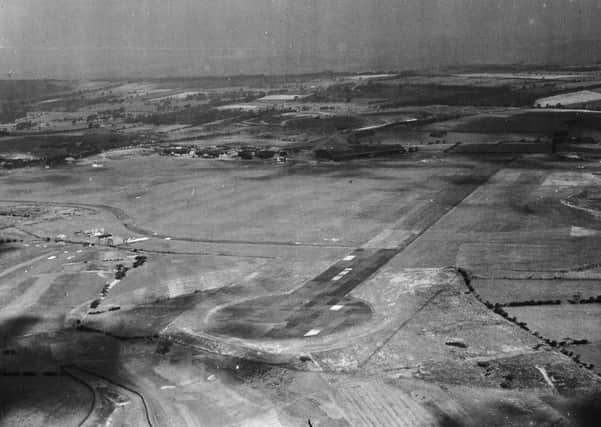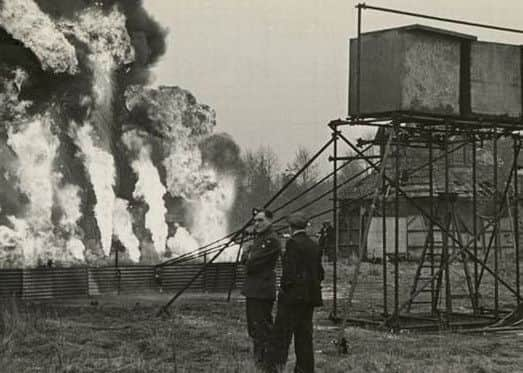Silence was secret weapon of war on the Home Front


The story of Bletchley Park, Britain’s secret wartime code breaking centre, and the men and women that worked there have become the stuff of legend. And rightly so.
But the wider story of Britain’s clandestine war effort and the people and places behind it is less well documented and something that author Colin Philpott explores in his new book, Secret Wartime Britain.
Advertisement
Hide AdAdvertisement
Hide AdIt tells the stories of some of the hidden locations that played a key role in winning the war and just how well the nation kept crucial wartime installations secret.


Philpott explores the role played by factories, command centres and listening bases, and how decoy and dummy sites helped the country’s wartime infrastructure withstand the Luftwaffe’s onslaught, and what has happened to them since.
Many of the locations remain relatively unknown to people and even today many aren’t normally open to the public. They include the replica Cabinet War Rooms built under a residential street in North London, what was Europe’s biggest single-span factory space created in a few months at the outbreak of war in Yorkshire, and the sinister remains of a chemical weapons factory hidden above and below ground in a Welsh valley.
Philpott, a former director of the National Media Museum turned author, looks at more than 60 sites across the country in detail and the role they played. “It’s not a complete list of every place in Britain that had a role in the war, it’s not an encyclopaedia, but what I’ve tried to do is look at different categories, so there’s factories, places that were command centres and places linked to espionage and code breaking.”
Advertisement
Hide AdAdvertisement
Hide AdHe says that entire dummy factories were built as decoys to try and protect key sites and locations. “Leeds, like most cities, was protected by decoy sites. There were 12 around the city and essentially they were places created just outside the city to try and make them look like an urban area. They used lights and fires and they were designed, with some success, to confuse the Luftwaffe about where the middle of Leeds was.”
The book looks at some of the retreats where the Royal Family would have been evacuated to had they needed to leave London. “Auxiliary units were set up at the start of the war designed to launch a counter- insurgency had there been a German invasion and this had lots of bases hidden around the countryside,” he says.
“It’s not just about bunkers. Quite a few of the places are underground but most of them are above ground. Most of Britain’s wartime factories were above ground and were often quite conspicuous, and I’m more interested in the ones that were hidden in plain sight.”
Sites like that of the old Avro Factory next to Leeds Bradford Airport. “At what is now the airport’s industrial estate there’s a vast, low building and it was built in 1939 in a great hurry as an aircraft factory – lots of new ones were built around the country and this was one of them. Around 17,000 people worked there throughout the war and fleets of buses took people there, and astonishingly it was never bombed and there are a number of reasons for that. Firstly, it was very well camouflaged, it was quite low and grassed over. Experts from the film industry were involved in this and they changed the look of it depending on the seasons.”
Advertisement
Hide AdAdvertisement
Hide AdIt shows the extent to which the authorities, and indeed ordinary people who worked in these factories, kept quiet about what they were doing.
“There was this belief that careless talk cost lives and there was a big propaganda drive to get people to not give away important information. A lot of offences were created at the start of the war under new Defence Regulations, but interestingly the number prosecuted for information type offences was miniscule. So by and large ordinary people did keep secrets.”
He believes there were several reasons for this. “It was a much more deferential society. We look back at the Second World War now and think the outcome was inevitable, but of course it wasn’t inevitable. It was a fight for survival and there was a strong sense from people I talked to who worked in places like the Avro factory that they didn’t want to say anything that might endanger the boys on the front line.”
Also, it wasn’t easy to spread gossip or leak information as there were no mobile phones and social media was the stuff of science fiction. “If someone started building a secret aircraft factory today it would probably be on Twitter within half an hour. But it was completely different during the war,” says Philpott.
Advertisement
Hide AdAdvertisement
Hide AdNot surprisingly, Bletchley Park features in his book. “People know the story but what I’m interested in is how secret it was and did it remain secret? And all the evidence suggests it did. When German intelligence officers were debriefed after the war they knew we had a code breaking operation but they didn’t know it was centred at Bletchley Park. It looked like any other country house in the Home Counties and it was a classic case of being hidden in plain sight by not drawing attention to itself.”
As he points out work there was very compartmentalised. “It’s quite possible that people who worked in a particular hut taking down codes wouldn’t necessarily know what was happening in the next hut.”
There are darker aspects that feature in the book including the places where the country made and stored chemical weapons. The use of such weapons had been banned by the Geneva Convention after the First World War but their production wasn’t and many people probably don’t realise that Britain even had them during the war.
“I spoke to a women who worked in the chemical weapons factory in North Wales who was an inspector of the finished product and she claimed that she didn’t realise the weapons she was looking at were actually chemical weapons. It sounds unbelievable but I think it’s credible because it was very much a ‘need to know’ basis and people didn’t ask too many questions.”
Advertisement
Hide AdAdvertisement
Hide AdRural areas also acted as a temporary home for many of the nation’s art treasures. “They were initially moved to country houses including some in Yorkshire, like Skipton Castle. But fairly quickly it was realised that most parts of the country were vulnerable to bombing and in the end they were moved to two big underground places.
“One was a quarry in Wiltshire and the other was in North Wales. They were the two main places where most, not all, of the art treasures were stored.”
Yorkshire certainly played its part in the defence of the realm. It was home to crucial ‘listening’ stations on Blubberhouses Moor and in Scarborough, providing the ears of Bletchley Park by intercepting signals that were then decoded.
Eden Camp, in North Yorkshire, was used as a POW camp and Doncaster and Catterick racecourses became so-called ‘cages.’ There were around about a dozen of these across the country where prisoners were sent to be assessed.
Advertisement
Hide AdAdvertisement
Hide AdAs Philpott says, the significance of these sites shouldn’t be underestimated. “We created the kind of command economy that the Soviet Union would have been proud of. Buildings were commandeered and places like the Avro factory made a massive contribution to the war effort in their own way.
“In the end, through a combination of camouflage, decoy systems and a lid being kept on information, the Luftwaffe’s attempts to destroy our war infrastructure were quite limited.”
Secret Wartime Britain – Hidden Places That Helped Win The Second World War, published by Pen & Sword, is out now, priced £25.
Keeping the country safe
Philpott’s book includes research from the National Archives and elsewhere about the number of prosecutions brought during the war under the specially-created Defence Regulations.
Advertisement
Hide AdAdvertisement
Hide AdFor example, only 1,930 people were found guilty of ‘misleading acts’ throughout the entire war, 361 of sabotage and just 131 for the ‘publication of disturbing reports’.
He also reveals just how successful Britain was at limiting the damage to vital wartime infrastructure caused by German air raids.
Although about a quarter of the 8,030 sites marked as ‘key installations’ across Britain were hit, damage was mostly superficial, repairs were swift and disruption of wartime industrial production was relatively minimal.